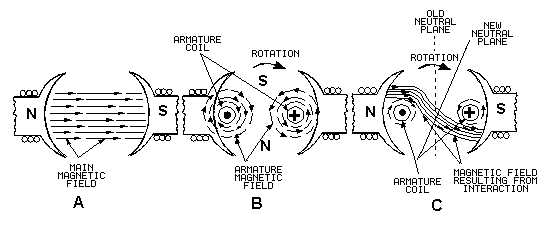1-9
Figure 1-8.—Armature reaction.
Now you have two fields — the main field, view A, and the field around the armature coil, view B.
View C of figure 1-8 shows how the armature field distorts the main field and how the neutral plane is
shifted in the direction of rotation. If the brushes remain in the old neutral plane, they will be short-
circuiting coils that have voltage induced in them. Consequently, there will be arcing between the brushes
and commutator.
To prevent arcing, the brushes must be shifted to the new neutral plane.
Q11. What is armature reaction?
COMPENSATING WINDINGS AND INTERPOLES
Shifting the brushes to the advanced position (the new neutral plane) does not completely solve the
problems of armature reaction. The effect of armature reaction varies with the load current. Therefore,
each time the load current varies, the neutral plane shifts. This means the brush position must be changed
each time the load current varies.
In small generators, the effects of armature reaction are reduced by actually mechanically shifting the
position of the brushes. The practice of shifting the brush position for each current variation is not
practiced except in small generators. In larger generators, other means are taken to eliminate armature
reaction. COMPENSATING WINDINGS or INTERPOLES are used for this purpose (fig. 1-9). The
compensating windings consist of a series of coils embedded in slots in the pole faces. These coils are
connected in series with the armature. The series-connected compensating windings produce a magnetic
field, which varies directly with armature current. Because the compensating windings are wound to
produce a field that opposes the magnetic field of the armature, they tend to cancel the effects of the
armature magnetic field. The neutral plane will remain stationary and in its original position for all values
of armature current. Because of this, once the brushes have been set correctly, they do not have to be
moved again.



